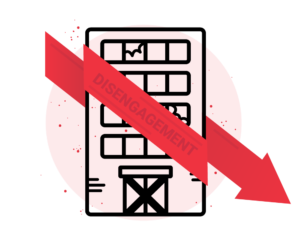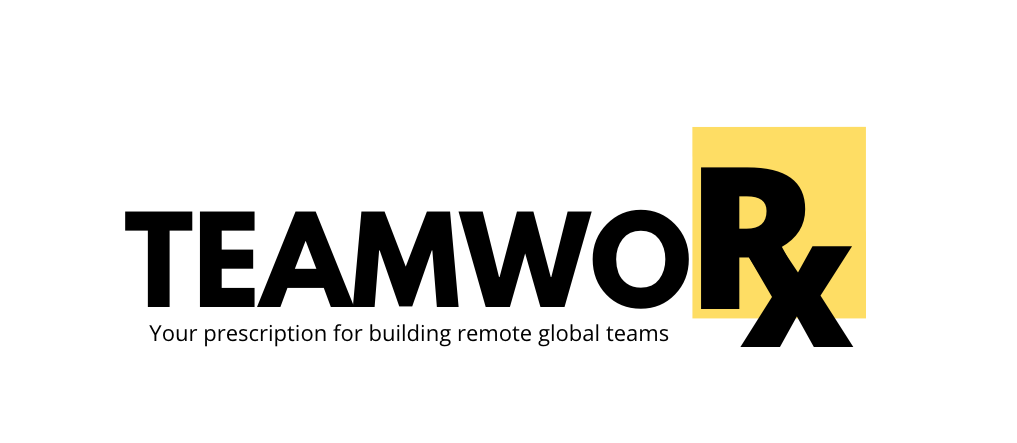How to overcome the four forces that destroy employee engagement
According to Gallup’s U.S. employee engagement survey, only about a third of American workers are engaged.

SOURCE: GALLUP
What about that other two-thirds? Fifty-one percent are not engaged, while 16 percent are actively disengaged.
Here’s an analogy: Imagine you have a team of 10 people using ropes to pull a boulder up a hill. Only three people would be pulling. Five would be trudging along and sort of pulling. One or two people would be actively sawing the ropes in half to watch the boulder roll down again.
As a leader, you can’t ignore employee engagement—especially as engagement levels are tied to business revenue.
The state of disengagement
Actively disengaged employees in the U.S. cost businesses $483 billion to $605 billion each year in lost productivity. But productivity isn’t the only disengagement “tax” on companies.
The effects of disengagement can be felt in:
- your ability to attract and hire great employees (disengaged employees may badmouth your company on sites like Glassdoor)
- voluntary and involuntary turnover
- stress and anxiety inflicted on peers and managers
- your consumer brand
- customer satisfaction
It’s no wonder companies are so focused on engagement. But what exactly is it?
Employee engagement defined
Engagement is an individual’s emotional commitment to his or her organization and its goals. Engagement is fueled by fit and satisfaction with one’s job, manager, organization, and coworkers, and it manifests as discretionary effort at work. Discretionary effort is going above and beyond minimum job requirements.
Engagement is linked to all sorts of positive impacts on employees and companies alike. For example, take a look at Gallup’s most recent Q12 report on employee engagement. Companies with highly engaged workforces outperform their peers by 147 percent in earnings per share. They also see 20 percent higher productivity and 21 percent higher profitability.
The bottom line is:
engagement matters.
But engagement isn’t a switch you can turn on. It’s something you need to work on as an organization in how you hire, how you manage your people and culture, and how you develop employees over time. You can’t just “get” somebody to become engaged—engagement is a choice and it must come from within. (More on that later.)

The impact of disengagement on business
There are various degrees and definitions of disengagement. Scholars have defined disengagement as “a negative, unfulfilling, work-related state of mind that is characterized by … infidelity and disloyalty,” and also “the withdrawing or defending of oneself physically, cognitively, or emotionally during work role performance.”
For our purposes, we usually talk about disengagement as the withholding of discretionary effort. As we mentioned earlier, discretionary effort is when employees do more than they have to. If employees put in extra hours, or put real passion into their work to make it something they’re proud of, that means increased productivity. It also means increased ownership and better results.
On the flip side, disengaged employees bring decreased productivity and decreased results. These employees are keeping you from achieving productivity and profitability. This is true whether they’re trudging along or actively trying to cut the rope.
Disengagement has repercussions at every level of your organization.
On individuals:
According to HBR, studies have shown that disengaged workers have “37 percent higher absenteeism, 49 percent more accidents, and 60 percent more errors and defects.” Actively disengaged employees also report more health problems. This includes high blood pressure, depression, and pain.
On teams:
Scholars have found that disengaged workers exhibit a toxic ripple effect on peers and teams. According to an HBR
study, 78 percent of employees said their commitment to the organization declined in the face of toxic behavior. Sixty-six percent said their own performance declined.

On culture:
According to an Axial study, companies with high disengagement were 40x less likely to identify their culture as a great place to work, compared to fully engaged employees. Disengagement is associated with lack of trust, increased bullying, lack of creativity, poor interpersonal relations, conflict, and loss of cultural values—among many other negative effects.
On business:
Organizations with low employee engagement scores experienced 18 percent lower productivity and 16 percent lower profitability. They also saw 37 percent lower job growth and 65 percent lower share price over time. In 2017, The Conference Board estimated that disengaged employees cost global companies between $450—$550 billion a year.
The four forces of disengagement
Where does disengagement come from? We’ve identified four main forces of disengagement that impact organizations. Any one of them can have devastating consequences for your employees, your teams, and your bottom line.

Misalignment with role

Misalignment with manager

Misalignment with team

Misalignment with culture
1. Misalignment with role
Nothing can cause a new hire to sour faster than discovering they’re not a good match for their job. Nearly half (46 percent) of newly-hired employees fail within 18 months. Only 19 percent achieve what can be considered straight-up success.
Often, existing employees flounder in roles that weren’t adequately defined—or haven’t evolved to fit the changing needs of the business.
Job fit is a significant contributor to employee engagement and productivity. Job fit is feeling like you’re able to be productive and satisfied in your work and within your company culture. When we hire someone whose behavioral traits are not matched to the role, we inadvertently set them up to fail. For example, if someone prefers to work heads down, that person would be miserable in a sales role. All day long they’d be stretching to be more extraverted and outgoing.
It’s possible to train and coach employees to develop new skills. Yet it’s preferable to seek out employees whose natural behavioral drives fit a role well to begin with. Here’s why: Even though you can teach people sales techniques—and even if they can successfully close deals—that doesn’t mean they’ll enjoy the work or take satisfaction from their accomplishments. And if they aren’t getting that adrenaline rush from success, they won’t feel engagement.
2. Misalignment with manager
The relationship one has with his or her direct manager is a critical contributor to employee engagement. According to Gallup, just 21 percent of employees strongly agree that their performance is managed in a way that motivates them to do outstanding work. Most managers are not equipped with the education and information they need to manage effectively. Most have no idea how to go about coaching and inspiring employees.
In our People Management Study, we saw a strong correlation between how employees feel about their managers and their attitude toward their jobs. In fact, according to that report, “94 percent of employees with great bosses have passion and energy for their jobs, whereas only 59 percent of employees with bad bosses have passion and energy for their jobs.”
3. Misalignment with team
Ninety-seven percent of employees believe lack of alignment on a team impacts project outcome. Another 86 percent blame workplace failures on lack of collaboration and ineffective communication. What’s more, 75 percent of employers rate teamwork and collaboration as “very important,” but only 18 percent make communications evaluations part of performance management. This is important because companies that don’t promote and enable collaboration are less likely to be high performing.
How can you create a more aligned team? Introduce employees to their peers’ communication styles and goals. Make sure to align everyone on a shared vision for the team as well as company goals and values. People who are rowing in the same direction and understand each other’s strengths are less likely to experience unhealthy conflict.
4. Misalignment with culture
When employees are misaligned with their corporate culture, they lack a feeling of belonging. This can impact performance. Lack of alignment can even create a toxic environment across the organization. This can be as simple as not feeling in tune with company values, feeling a lack of meaning and purpose, or having a lack of trust in company leadership. But it can also be a profound disconnect and feeling of isolation and loneliness, which can lead to disengagement.
Mentoring, coaching, and hiring employees in cohorts can help you to build camaraderie, support, and cultural alignment. There are also various ways to build an energized and productive culture from introducing a shared vocabulary to giving employees the tools to understand themselves and their co-workers better.
How to build engagement
As we mentioned at the top of the post, you can’t just “get” somebody to become engaged—employees must choose to be engaged.
As Cy Wakeman said in her book “NO EGO,” engagement is tied to accountability. Here’s why: engagement comes from being challenged to push yourself and succeeding. If an employee faces an obstacle and the manager moves mountains to make the obstacle much less challenging, the employee won’t derive much accomplishment from success. On the other hand, if the manager sets the bar high and ensures the employee has the needed tools and knowledge to succeed, the employee will feel excited when they do succeed—because they were accountable for the results.
It’s your job as a manager to grow accountability over time. You must also ensure the following:
1. Job fit
One critical component of engagement is job-person fit. If you’re hiring, you’ll want to administer behavioral and cognitive assessments to ensure the candidate is well-suited to the role. (Being in the wrong job is like writing with your non-dominant hand for eight hours a day, five days a week.)
For employees, offer challenging, meaningful, and achievable work, and then acknowledge success to drive a higher level of engagement. You’ll also want to redefine any job that has evolved over time to meet business needs. The employee in the role might no longer be a great fit. You should identify and address this as early on as possible before the employee disengages.
2. Manager alignment
Manager-employee relationships are routinely cited as one of the most important factors in employee engagement. Provide managers with tools and training to understand, support, and challenge each of their employees. Consider having every employee take a behavioral assessment and giving managers access to customized coaching guides so they can coach and guide employees in a manner that will be most effective.
Managers must also work on being self-aware. They can ask for feedback, take a quiz, or use a Manager Development Chart that identifies areas of weakness and gives actionable tips.
3. Team dynamics
Even the best manager cannot always correct for team misalignment. Feeling valued, involved, and respected on a team is critical. Foster relationships by giving employees a deeper understanding of one another’s drives, needs, and communication styles. Make sure leaders are also informed and sensitive to team composition and dynamics—Team Work Styles is a useful tool to find and fill gaps on a team.
You’ll also want to build a diverse team so you can benefit from a wide variety of skills and experience. The best leaders understand that they don’t need to know everything—they have to surround themselves with a diverse team and draw on their combined knowledge.
4. Culture alignment
Each time we bring the wrong people into our culture we shift that culture further from where we want to be. Bad hires—no matter how skilled—will never thrive, and will usually cause toxicity to grow. As we discussed in our webinar on optimizing employee engagement, these “bad hires” are your silent killers (low engagement, low performing) and your contaminators (low engagement, low performing).
Take care to build a harmonious culture. Do frequent employee engagement surveys and pay special attention to the feedback you get from your high-performers. Take the time to cooperatively craft and communicate your mission and build an employee engagement strategy. Establish and live your values, and bring your people into alignment around them.
Engagement efforts must be ongoing.
Engaging employees takes work. Your efforts to hire, onboard, and manage employees in thoughtful ways should be constant. Once employees are on board, make the effort to understand their individual motivations, behaviors, and goals. Keep finding new ways to challenge them and support their desires for personal and professional growth.
Measure engagement through regular surveys, 1:1 conversations, “best place to work” style surveys, and development conversations. Measure disengagement through looking at turnover intentions, employer brand, performance reviews, and employee NPS surveys.
But remember, even if you’re doing well and have a highly-engaged team, don’t award yourself an engagement trophy and stop working to help employees thrive. Continue to measure and invest in engagement and you’ll see significant rewards. But let even the most engaged team languish, and you’ll see the opportunistic effects of disengagement begin to creep in.
If you are looking for a ‘rubber meets the road’ solution for engaging your people, check out TeamwoRx. The system creates immediate and long-term engagement that truly sticks.
Leveraging a scientific, data-driven platform with high-touch Be Legendary engagement and a fast feedback loop will take your company, department or division to the next level of success and crush your goals.
This step-by-step initiative will get every leader in alignment with their teams, and with one another, and launch you forward to ‘impossible’ results.
While you can repeat the initiative, during our 12-month initiative, we will:
-
Provide you a technology platform to hire and diagnose your talent using actionable insights at your fingertips
-
Help your leaders engage and inspire your people to gain a deep understanding of how to continue long after we are gone
-
Teach your leaders a repeatable step-by-step process that every new person to your business will go through on their way to achieving incredible results


